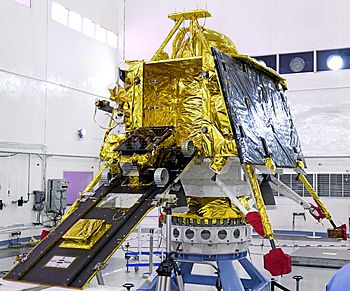Pragyan (rover) facts for kids

Pragyan rover mounted on ramp of Vikram lander
|
|
| Mission type | Lunar rover |
|---|---|
| Operator | ISRO |
| Mission duration | CH2: 0 days (landing failure) CH3: 14 days (planned) |
| Spacecraft properties | |
| Manufacturer | ISRO |
| Landing mass | CH2: 27 kg CH3: 26 kg |
| Dimensions | 0.9 m (3.0 ft) × 0.75 m (2.5 ft) × 0.85 m (2.8 ft) |
| Power | 50 W from solar panels |
| Start of mission | |
| Launch date | CH2: 22 July 2019 14:43:12 IST, (09:13:12 UTC) CH3: 14 July 2023 14:35 IST, (9:05 UTC) |
| Rocket | LVM3 M1, LVM3 M4 |
| Launch site | SDSC Second launch pad |
| Contractor | ISRO |
| Deployed from | Vikram lander |
| Deployment date | CH2: Intended: 7 September 2019 Result: Never deployed from destroyed lander. CH3: 23 August 2023 |
| Lunar rover | |
| Landing date | 6 September 2019, 20:00-21:00 UTC |
| Landing site | Attempted: 70.90267°S 22.78110°E (Intended) Crash landing at least 500m away from planned site. (Actual) |
| Distance covered | 500 m (1,600 ft) (intended) |
Pragyan (which means "wisdom" in Sanskrit) is a special robot, called a rover. It was built by the Indian Space Research Organisation (ISRO) for India's Moon missions. Pragyan was part of both the Chandrayaan-2 and Chandrayaan-3 missions.
The Chandrayaan-2 mission launched on 22 July 2019. Sadly, Pragyan was destroyed with its lander, Vikram, when it crashed on the Moon on 6 September 2019. It never got to explore the lunar surface.
But the story didn't end there! The Chandrayaan-3 mission launched on 14 July 2023. This time, the lander successfully touched down on the Moon on 23 August 2023. This allowed the new Pragyan rover to begin its important work.
What Pragyan Does
The Pragyan rover is like a small car designed to drive on the Moon. It weighs about 27 kilograms (about 60 pounds). It gets all its power from solar panels, using the Sun's energy.
This rover moves on six wheels. It was designed to travel up to 500 meters (about 1,640 feet) across the Moon's surface. It moves very slowly, at about 1 centimeter (less than half an inch) per second. While moving, it studies the lunar surface and sends information back to its lander. The lander then relays this data to Earth.
To help it navigate, Pragyan has special cameras:
- 3D Vision Cameras: It has two 1-megapixel cameras at the front. These cameras help the team on Earth see the Moon's surface in 3D. This helps them plan the best path for the rover to take.
- Strong Wheels and Suspension: The rover has a special "rocker-bogie" system with six wheels. Each wheel has its own motor. This design helps it move over rocky and uneven ground. It can steer by changing the speed of its wheels.
Pragyan was built to work for about one lunar day, which is equal to 14 Earth days. This is because its electronics are not made to survive the extremely cold lunar night. However, it has a system that lets it "sleep" during the night and "wake up" when the Sun returns. This could allow it to work for even longer than planned!
Here are some quick facts about Pragyan:
- Size: 0.9 meters (length) × 0.75 meters (width) × 0.85 meters (height)
- Power: 50 watts (from solar panels)
- Speed: 1 centimeter per second
- Planned Mission Time: Up to 14 Earth days
Where Pragyan Landed
The Chandrayaan-2 mission had two main spots picked out for landing. These areas were chosen carefully to make sure the lander and rover would be safe. They looked for flat areas with gentle slopes and not too many large rocks. They also needed places that would get enough sunlight for at least 14 days.
The main landing spot was at 70.90267°S 22.78110°E. This area is on the side of the Moon that always faces Earth, near the Moon's South Pole. It's located between two craters called Manzinus C and Simpelius N.
Scientists believe this area might have special rocks from deep inside the Moon. This is because a huge impact long ago might have dug up material from the Moon's inner layers. Studying these rocks could teach us a lot about how the Moon was formed.
The 2019 Crash Landing
In 2019, the Vikram lander, carrying the first Pragyan rover, separated from the Chandrayaan-2 orbiter. It was supposed to land softly on the Moon on 7 September 2019.
At first, everything seemed to be going well. The lander followed its path and performed important braking steps. However, when it was about 2.1 kilometers (about 1.3 miles) above the surface, its path changed. The lander's computers were in control, and mission control on Earth could not fix the problem.
The last signals from Vikram showed it was moving very fast, about 58 meters per second (about 130 miles per hour), when it was 330 meters (about 1,080 feet) above the surface. This speed was too fast for a gentle landing.
ISRO confirmed that the lander had a "hard landing," meaning it crashed. Later, images from another spacecraft, the Lunar Reconnaissance Orbiter, showed the crash site. The pictures confirmed that both the Vikram lander and the Pragyan rover inside were destroyed by the impact. Debris from the crash was spread out over a large area.
Even though the lander crashed, the orbiter part of the Chandrayaan-2 mission kept working. It had eight science tools and continued to orbit the Moon, studying it for several years.
See also
- Artemis program
- Indian Space Research Organisation
- Luna-Glob
- Lunar rover
- Rover (space exploration)

